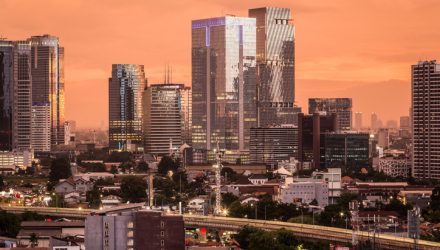After years of lagging domestic benchmarks, such as the S&P 500, emerging markets equities may finally be ready for some out-performance. Investors looking to take a conservative, quality-based approach to that play should consider the FlexShares Emerging Markets Quality Low Volatility Index Fund (NYSE: QLVE).
QLVE employs a quality screen to provide exposure to high-quality companies with lower absolute risk, thereby limiting potential future volatility. The quality screen analyzes a broad universe of equities based on key indicators such as profitability, management efficiency, and cash flow, and then excludes the bottom 20% of stocks with the lowest quality score. The index is then subject to the regional, sector and risk-factor constraints, in order to manage unintended style factor exposures, significant sector concentration, and high turnover.
“In particular, emerging markets have underperformed the S&P 500 index since 2010. From its 2010 peak, the MSCI Emerging Markets index has underperformed the S&P 500 by 65%. It’s no surprise that the 10 largest stocks in the world by market capitalization are U.S. companies,” reports Andrew Addison for Barron’s.
Engaging Emerging Markets With QLVE
With the U.S. and China having a “phase one” trade deal in place, emerging markets (EM) equities have been feeding off the anticipation since last year’s late rally. The deal is essentially the train engine pulling developed market freight cars along while the EM space, the caboose, happily trails behind—last in line, but still moving forward.
“While emerging markets have been in a nine-year bear market since their 2011 top, the outlook is beginning to brighten,” according to Barron’s.
Factor-based strategies like smart beta ETFs can be used to solve different portfolio needs. For instance, single factors help target exposure to enhance returns or address specific client needs, whereas a multi-factor approach may provide a diversified core equity allocation that leverages the benefits of multiple factors and limit cycle risks associated with individual factors.
QLVE’s low-volatility investment methodology may limit upside potential, could come with high turnovers and exhibit sector or regional concentration risks due to the nature of the strategy.
Related: A Quality Dividend Idea With a Bright 2020 Outlook
Growth is also expected for a slowdown. The U.S. experienced a trailing 5-year real GDP growth rate of 2.6%, but Northern Trust anticipates the U.S. experience a 5-year annualized GDP growth rate of 1.7% ahead. Meanwhile, other developed economies in Europe, Japan, the United Kingdom, and Canada will also see growth lower than the U.S.
QLVE’s 2020 utility could be further aided by an accommodative Federal Reserve, which could further cut interest rates.
Global central banks could also affect outcomes for emerging markets assets this year. U.S. monetary policy has caused big ripples on central banks in emerging markets due to the influence over global flows of capital and currency moves. When the U.S. hikes rates, it encourages investors to bring their capital back home, forcing developing countries to follow suit even if it means crippling their own economies to keep their domestic currencies steady against the greenback and avoid a jump in inflation as the prices of imports rise.
For more on ETF strategies, please visit our Multi-Asset Channel.
The opinions and forecasts expressed herein are solely those of Tom Lydon, and may not actually come to pass. Information on this site should not be used or construed as an offer to sell, a solicitation of an offer to buy, or a recommendation for any product.

